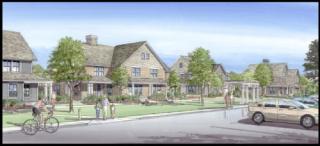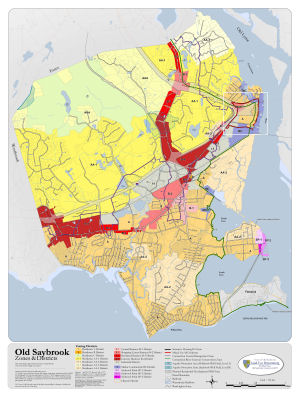Incentive Housing

As a part of a State program to create affordable workforce housing, towns may adopt a local incentive housing zone (IHZ). After studying the applicability of the tool, Old Saybrook's land use commissions found potential for the additional layer of development rights to be consistent with the underlying uses already existing in several areas of town.
The intended outcome of the Incentive Housing program is to encourage affordable housing in both residential and business districts that have the transportation connections, nearby access to amenities and services, and infrastructure necessary to support concentrations of development. The IHZ seeks to avoid sprawl and traffic congestion by encouraging a more vibrant residential component nearby business or within mixed use areas to sustain a lifestyle in which residents can walk or use public transportation to reach jobs, services, and recreational or cultural opportunities.
Zone
The IHZ is a land use tool intended to overlay existing zoning (does not make any existing permitted use non-conforming) to give an additional layer of development rights for property owners to create workforce housing, 20% of which would be deed-restricted as "affordable" at or below market rates of sale or rent.
In 2009, the Zoning Commission adopted the first IHZ in a portion of the Ferry Point neighborhood. The Ferry Point IHZ encompasses a mixed-use subzone to better transition between those uses that are currently existing or permitted to exist within the underlying districts -- Residence (A), Shopping Center Business (B-2), Marine Commercial (MC), and Industrial (I). The mixed-use subzone allows, by special exception, diverse neighborhood businesses, such as a bank, convenience store, daycare, hair care, laundry, liquor store, restaurant, supermarket or theater, to locate within walking distance of residences.
Regulations
The IHZ is designed to create opportunities for context-sensitive infill and redevelopment of neighborhoods that meet criteria for pedestrian-orientation, whether existing or potential. The capacity for intense development is still limited to a "soils-based density", meaning the Town's sewer avoidance policy acts as a natural growth management tool to keep development compatible with the town's historical patterns. The incentives for property owners include higher density, stream-lined permitting, and lessened bulk regulations than the underlying district; and for towns, a payment for adoption of the zone and for permitting of the buildings (subject to availability of State funds). Furthermore, the IHZ may enable adaptive reuse of existing, historic or underutilized buildings or properties in Old Saybrook that may otherwise be lost to progress.
 Consistency with Town Plan. Incentive housing is consistent with the Residential Development section of the Town's Plan of Conservation & Development:
Consistency with Town Plan. Incentive housing is consistent with the Residential Development section of the Town's Plan of Conservation & Development:
Goals
Provide sufficient opportunity for creation of housing alternatives to the typical high-cost single-family house in order to:
- Accommodate the elderly in a safe and convenient environment
- Enable young persons to continue to both live and work in town
- Create attainable housing for families at all income levels
- Balance rates of development with existing capacity and planned expansion of public infrastructure and services.
- Encourage design of new and renovated housing that is compatible with its surrounding neighborhood
Policies
- To promote additional multi-family opportunities that do not require owner residence including limited apartment facilities, home conversions, and non-ground floor apartments over Main Street businesses where soils can accommodate waste disposal.
- To continue to encourage creation of accessory apartments within larger single-family dwellings where single-family character and adequate parking and utilities and soil conditions permit.
- In the residential area north of I-95:
- to assure that new residential development is fitted to the significant natural constraints of topography, variable soil conditions, and wetlands
- Where land conditions are supportive, to provide an opportunity for alternative forms of residential layout and buildings that best utilize individual site features.
- To continue to seek solutions to access and internal circulation problems for the area as a whole.

